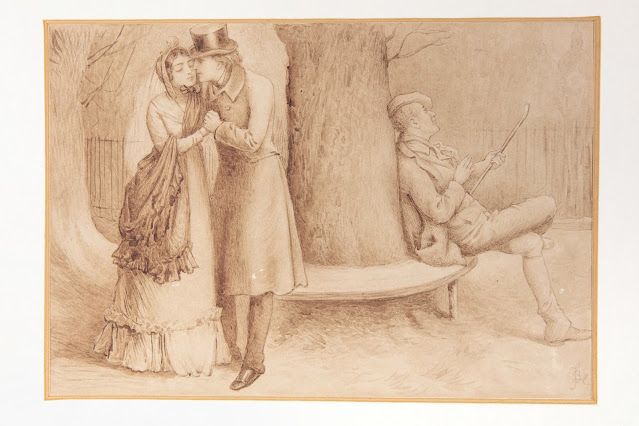A Great and Dirty City: Dickens and the London Fog
New Exhibition at the Charles Dickens Museum at Doughty Street, London
Scene from Dickens's novel Martin Chuzzlewit depicting two characters kissing in the fog, sepia wash illustration by Fred Barnard © Charles Dickens Museum, London and reproduced with their kind permission.
Fog everywhere. Fog up the river, where it flows among green aits and meadows; fog down the river, where it rolls defiled among the tiers of shipping and the waterside pollutions of a great (and dirty) city. Fog on the Essex marshes, fog on the Kentish heights. Fog creeping into the cabooses of collier-brigs; fog lying out on the yards, and hovering in the rigging of great ships; fog drooping on the gunwales of barges and small boats. Fog in the eyes and throats of ancient Greenwich pensioners, wheezing by the firesides of their wards; fog in the stem and bowl of the afternoon pipe of the wrathful skipper, down in his close cabin; fog cruelly pinching the toes and fingers of his shivering little prentice boy on deck. Chance people on the bridges peeping over the parapets into a nether sky of fog, with fog all round them, as if they were up in a balloon, and hanging in the misty clouds. BLEAK HOUSE ONE
On the 29th March 2023 'The Dickens and the London Fog' opened at the Charles Dickens Museum. Well presented and a helpful balance of Dickens references and historical background. And a good starting point is chapter one of Bleak House quoted above. The novel opens with the one word sentence 'London'. It does not take long for the fog to be introduced. In chapter 3, Esther Summerson, who narrates part of the novel, arrives in London.
I asked him whether there was a great fire anywhere? For the streets were so full of dense brown smoke that scarcely anything was to be seen.
O dear no, miss,he said. This is a London particular.
I had never heard of such a thing.
A fog, miss, said the young gentleman.
O indeed!said I. BLEAK HOUSE THREE
Of course fog was not ever present to become a fixed feature of London existence as (say) the River Thames. But the displays make the point the contributing factors: London was built in a river basin, its population doubled from 1800-1850. The use of coal fires prevailed for both industrial and domestic use. This would of course mean that November, when the weather grew colder, saw a rise in coal use and the emergence of the fog. Then the fog would dominate when there was a high pressure, with less wind. And could still be around in December as featured in 'A Christmas Carol' ...The fog came pouring in at every chink and keyhole, and was so dense without, that although the court was of the narrowest, the houses opposite were mere phantoms. To see the dingy cloud come drooping down, obscuring everything, one might have thought that Nature lived hard by, and was brewing on a large scale. A CHRISTMAS CAROL
Making the point, that the fog could intrude into the home. ( During the great London smog of 1952 fog even got cinemas and theatres ) .It was a horrible colour and would have a stench-reminding one of Esther 's view of 'brown smoke'. Also oily. Would be interested to know how the London fog impacted on the cloth trade.
Dickens's fireside poker, from his Chads Hill home, is on display like a relic, at the exhibition. The fireplaces in Dickens home at Doughty Street emphasise how many coal fires a large town house could contain. Then there was the coal cellar with its own hatch on to the street, to avoid sacks of coal been take through the house.
The Exhibition makes the point that the fog created by industrialisation was not just an issue for London, directing one to 'Hard Times' set in fictional 'Cokestown ' It was a town of machinery and tall chimneys, out of which interminable serpents of smoke trailed themselves for ever and ever, and never got uncoiled. HARD TIMES
Fog could be used to hide assignations as in that of the young Martin Chuzzlewit and Mary Graham, which the illustration above could be depicting.
There is a timeline in the Exhibition highlighting the fact that there was already a report published from the Parliament Select Committee on Smoke Prevention in 1843. There was also a Smoke Abatement Exhibition held in London in 1881. ( This was followed by two years where the fog was quite severe).
The Great Smog of London of 1952 ( the 'pea souper') was meant to have killed some 12,000 people. Was so thick the police officers used flares to guide people through the traffic. Strange to think that the first chapter of 'Bleak House' referred to such a scenario some 99 years before. The Clean Air Act of 1956 is generally held to have been passed in response.
The exhibition also reminds us that the term 'smog' ( smoke and fog') was not used by Dickens, as only entered written English in 1905.
The exhibition is small but thought provoking . Great combination of literature, biography and social history. Admission included with standard entrance to the Charles Dickens Museum and its last day is the 22nd October 2023.
Further Reading
Charles Dickens Museum Page about the London Exhibition.
Foggy Past in Conan Doyle's work Looking at The Strand magazine, the Sherlock Holmes stories that it featured and the role of the London Fog.
There is also 'The London Fog-A biography' by Christine L Corton (2015) . I have not got round to reading it.
The Great Stink II - The Smog of London 1952 Excellent documentary accessed on Youtube 15th April 2023,
Another blog by Michael Bully
A Burnt Ship 17th century War and Literature.



.jpg)
Comments
Post a Comment